Regular readers will remember the author’s article in spring 2016 about top Beverley, East Yorkshire producer Ian Broumpton. Given that Ian has 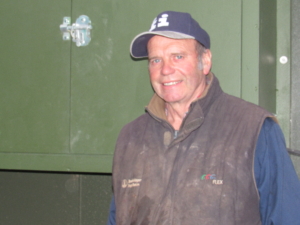 been doing what Yorkshire folk are renowned at NOT doing, namely spending money, or “brass” in Old English, it seemed timely to go and see what Ian has been up to over the last two years.
been doing what Yorkshire folk are renowned at NOT doing, namely spending money, or “brass” in Old English, it seemed timely to go and see what Ian has been up to over the last two years.
Ian is still as fiery as ever, his current rant being related to red tape. “Supposedly one of the reasons for Brexit was that it should mean less red tape, but I reckon that the British government will increase it,” said Ian with a wry smile on his face. Ian has increased his herd size to 330 productive females and 60 maiden gilts. Ian’s productivity has always been excellent, hence he has carried on with his criss-cross policy using Topigs Landrace dam line semen and keeping F2 gilts as replacements. Using F2 females is supposed to result in lower litter size vs F1s. Having said that Ian’s F2s are currently farrowing 13.52 born alive, better than many herds working with F1 females. Whilst criss-crossing has the benefit of perceived higher health status as the herd is closed, Ian admits that it’s hard work and will soon start to buy in the T9 F1 gilt from JSR. This is something of a double-edged sword as buying in gilts is not without risks but an F1 female should produce more pigs.
The AHDB Pork data shows the top 10 per cent of herds are farrowing 14.25 pigs/ born alive so Ian is currently 0.73 pigs down in that respect. The JSR 900 sire line has proved its worth in producing very lean slaughter pigs and is still Ian’s preferred choice.” The two weekly batch farrowing system is working well and the farrowing index of 2.42 litters / sow / year bears testament to that.
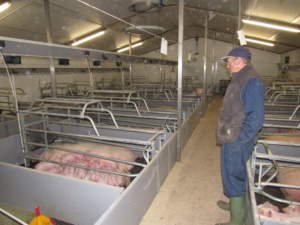 The aim is to farrow 30 sows and gilts per batch, with the farrowing females still all being hand fed 16.1 per cent CP, 0.99 per cent lysine pelleted ration twice a day, up to a maximum of 8kg. Ian swaps home grown grains for finished feed with Manor Farm Feeds, a small farm-based feed compounder just 20km away. A new move recently has been to buy some rations from Thompson’s, a feed miller based near York, which gives Ian a bit more flexibility in terms of feed supply. Sows are still induced, with a proprietary prostaglandin, along with 05ml of an oxytocin analogue, to speed up farrowing. The 12 crate AMWarkup fully slatted farrowing house is now three years old. Ian has been so impressed with it that it spurred him on to build another 30 place fully slatted AMW farrowing facility, (three rows of 10 crates) in October 2017.
The aim is to farrow 30 sows and gilts per batch, with the farrowing females still all being hand fed 16.1 per cent CP, 0.99 per cent lysine pelleted ration twice a day, up to a maximum of 8kg. Ian swaps home grown grains for finished feed with Manor Farm Feeds, a small farm-based feed compounder just 20km away. A new move recently has been to buy some rations from Thompson’s, a feed miller based near York, which gives Ian a bit more flexibility in terms of feed supply. Sows are still induced, with a proprietary prostaglandin, along with 05ml of an oxytocin analogue, to speed up farrowing. The 12 crate AMWarkup fully slatted farrowing house is now three years old. Ian has been so impressed with it that it spurred him on to build another 30 place fully slatted AMW farrowing facility, (three rows of 10 crates) in October 2017.
Again, the new farrowing facility has heat mats plus a lamp hung over the sow’s rear and which is just used for the first 24 hours post farrowing. Ian still “lives” in the farrowing house at pigging time and his attention to detail pays off, with stillborns running at a highly creditable 0.8 piglets/ litter along with 13.52 born alive. Colostrum is still milked from some sows to give to his weaker piglets and an extensive fostering programme is carried out 24 hours after the piglets are born.
“To get gilts milking they often end up with 14 or even 15 piglets” added Ian. Litters are introduced to For Farmers Viva pre-starter (19 per cent CP, 0.6 per cent lysine) mixed with water and which is very palatable. Creep (21 per cent CP, 1.6 per cent lysine) is introduced later with weaning taking place at four weeks.
Ian has also spent money on his weaner accommodation. A six pen flat deck has been converted into a “big pen” which has been fitted with a “river 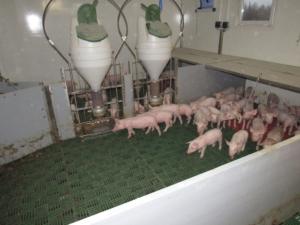 flow” trough which makes drinking easier for the weaners. Also getting rid of the passage means more space for pigs. Ian is a forward thinker and is mindful that zinc oxide will eventually be banned in diets and hence is carrying out an extensive trial using a buffered organic acid product versus zinc oxide. Ian has observed that the pigs on the acid treatment eat more (zinc oxide being an appetite suppressant) but are looser, which was a concern initially, and produce more manure, but it will be interesting to see the results when the trial is completed.
flow” trough which makes drinking easier for the weaners. Also getting rid of the passage means more space for pigs. Ian is a forward thinker and is mindful that zinc oxide will eventually be banned in diets and hence is carrying out an extensive trial using a buffered organic acid product versus zinc oxide. Ian has observed that the pigs on the acid treatment eat more (zinc oxide being an appetite suppressant) but are looser, which was a concern initially, and produce more manure, but it will be interesting to see the results when the trial is completed.
A further investment has been made in a Finrone nursery. Finrone manufactures containerised buildings, made in N. Ireland and transported by truck to farms. This nursery houses the smaller weaners in four pens x 35 pigs. The design is very similar to Danish weaner houses, with part slatted floors, heat pads and lids over the lying area. Two Aco Funki feeders containing a 19.6 per cent CP, 0.38per cent lysine weaner ration are fitted in the pen division. Ian had a fully slatted Skov ventilated pen finishing house built in 2009, housing pigs in groups of 31. This house has worked extremely well and Ian had always planned to extend it when funds allowed for this. The new extension (which also is fitted with automatically filled Canadian made Crystal Spring feeders) contains 360 pigs and is identical to the older house, apart from the fact that in the new house the whole pen front opens plus LED lighting makes things much brighter. Finishers receive a 16.3 per cent CP 1.1per cent lysine diet fed ad lib.
When package deal buildings first appeared back in the 1970s building manufacturers simply installed bulkhead lights to cut costs — which were simply far too dim – there’s nothing worse than trying to check pigs in poorly lit buildings and the new LED lighting is fantastic.
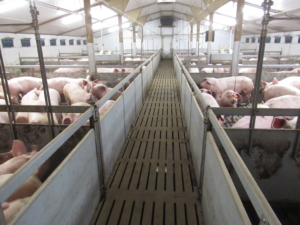 Slaughter pigs still go to local abattoir Cranswick. Pigs are on a 14mm P2 contract with pigs averaging 10.5mm P2 at 84kg deadweight so there is plenty of leeway, fat wise, in that respect. Fifty per cent of the G/F pigs still have to be finished off site, but now they just go to one farm. After weaning, sows are inseminated twice, 24 hours apart, with sows and gilts being inseminated in yards. The dry sow & gilt accommodation has been changed considerably. The ESF has been scrapped and that yard now houses growers for 6 – 7 weeks. Sows were hard to find for injecting and preg checking so now all females are kept in the yards in groups of 30-35, by their service dates. The yards are straw bedded but too big – despite being built to Government recommendations, so manure build up is an unwanted problem. Ian is known throughout the UK industry as “Mr. Bucket and Chuck it”. This is a humorous reference to Ian’s feeding technique. A feed barrow is wheeled along a catwalk which is located above all the sow yards and gestation sow feed (11.2 per cent CP, 0.63 per cent lysine) is simply dispensed by gravity, using a bucket. The catwalk also makes an excellent viewing area, so any problems can be easily spotted. Many experts would argue that in pig sows and gilts need to be individually fed to get maximum output but Ian’s method counters that suggestion. Gilts are batched by squirting a heat synchroniser onto a third of the feed ration for 18 days.
Slaughter pigs still go to local abattoir Cranswick. Pigs are on a 14mm P2 contract with pigs averaging 10.5mm P2 at 84kg deadweight so there is plenty of leeway, fat wise, in that respect. Fifty per cent of the G/F pigs still have to be finished off site, but now they just go to one farm. After weaning, sows are inseminated twice, 24 hours apart, with sows and gilts being inseminated in yards. The dry sow & gilt accommodation has been changed considerably. The ESF has been scrapped and that yard now houses growers for 6 – 7 weeks. Sows were hard to find for injecting and preg checking so now all females are kept in the yards in groups of 30-35, by their service dates. The yards are straw bedded but too big – despite being built to Government recommendations, so manure build up is an unwanted problem. Ian is known throughout the UK industry as “Mr. Bucket and Chuck it”. This is a humorous reference to Ian’s feeding technique. A feed barrow is wheeled along a catwalk which is located above all the sow yards and gestation sow feed (11.2 per cent CP, 0.63 per cent lysine) is simply dispensed by gravity, using a bucket. The catwalk also makes an excellent viewing area, so any problems can be easily spotted. Many experts would argue that in pig sows and gilts need to be individually fed to get maximum output but Ian’s method counters that suggestion. Gilts are batched by squirting a heat synchroniser onto a third of the feed ration for 18 days.
Regarding vaccinations, sows and gilts are given Gletvax, M+ Pac (EP), Eryparv PRRS & Circoflex. Piglets are vaccinated against PRRS at two weeks along with Circoflex and M+Pac at weaning. Ian continues to promote British pork and uses social media to great effect. Pork mince is very versatile, in burgers as a quick meal, but we simply don’t see enough of it in supermarket chill cabinets.
So what of the future? We have an ageing industry which is a big worry. However, Ian is lucky to have son Dan working alongside “to keep me straight and help with decisions – two heads are always better than one,” he said.
UK pig prices have been good for the last 15months. Ian has taken advantage of that and invested £250,000 in that period and in fact the business has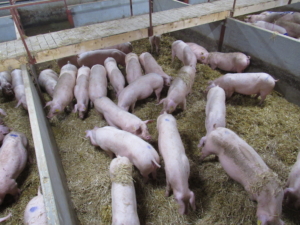 invested close to £1 million in the last 10years.
invested close to £1 million in the last 10years.
“Brexit is sure to mean cheap imports hence modern efficient buildings are essential to keep our production costs as low as possible.” Ian is currently producing 28.9 pigs / weaned / sow / year, which is up 2.9 from two years ago. Once the new gilts get into P 3, 4 & 5 productivity will be well above 30 pigs/ sow / year, which will put Ian into the Top10 per cent of UK producers.
It’s fantastic to see a British, sorry, Yorkshire, pig farmer who has the confidence to invest such substantial amounts of capital in his business. Let’s hope Ian’s peers are doing the same as insurance against an uncertain post-Brexit future and not simply shelling out on a new £80,000 Range Rover or on World Cruises.
In the UK our indoor breeding herd is now down to around 250,000 sows and gilts which is getting perilously low. Twenty years ago it was three times that number- 750,000. If we had more pig farmers with as much confidence in the future as Ian then our national pig numbers would be far more respectable and we wouldn’t be importing as much pigmeat as we currently do.
Bravo Ian!! •
— By Norman Crabtree




